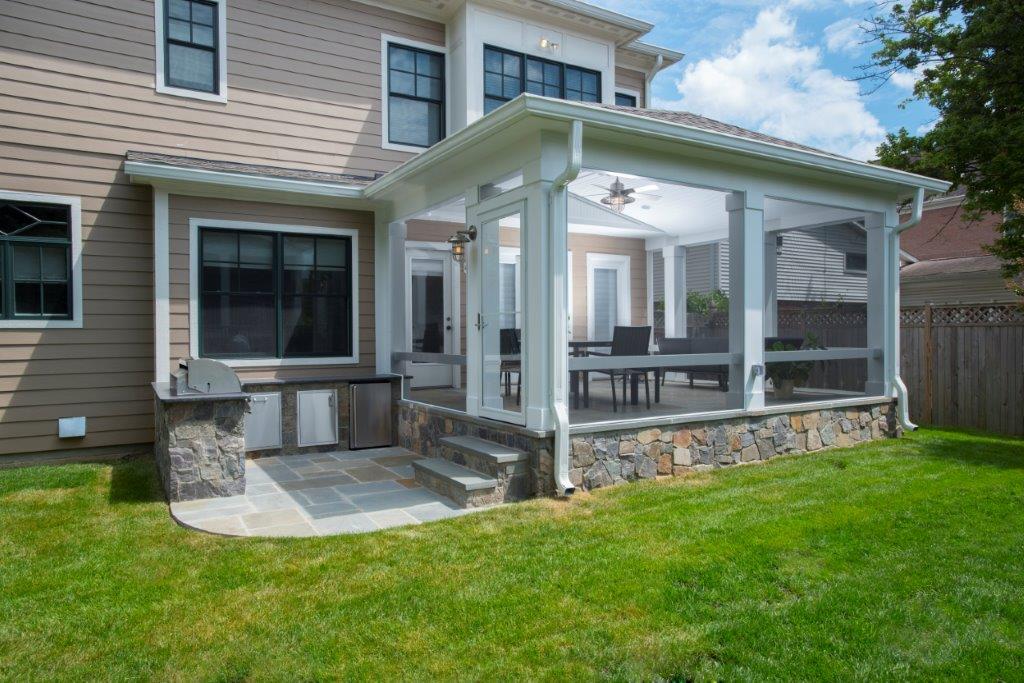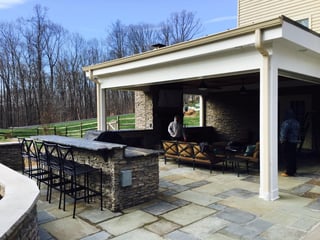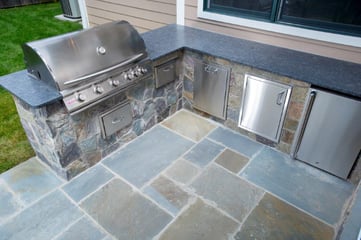
If you’re building an outdoor kitchen, you’ve probably already started investigating your options for outdoor cabinetry. In this industry, however, there are a staggering number of options, and that can quickly become overwhelming. To help you choose between plastic, stone, and steel (the most common outdoor kitchen materials), the following is an overview of some of the main differences, drawbacks, and benefits of each material type. From there, it’s just a matter of deciding what fits your personal preferences, budget, and environment.
Weather Conditions
One of the biggest issues with outdoor cabinetry is that the units are going to be exposed to potentially extreme weather. This could include large swings in temperature, abundant moisture, and even possibly salt (if you live near a body of saltwater).
This is especially important to consider, since cellular PVC or vinyl (plastic cabinets) are subject to expansion and contraction with heat and cold. Depending on the severity of the temperature swing, this could cause enough of a change in shape and size that it will present problems with the doors of the cabinets opening, closing, and aligning properly.
Because of stainless steel’s structural integrity, this isn’t going to be a problem with that material. Even in extreme conditions, the stainless steel isn’t going to warp, bend, expand, or contract.
This also speaks to a general quality issue. Stainless steel is simply going to outstrip plastic in terms of quality, but it’s also going to be pricier, so you’ll have to decide what works best for your desired results and budget.
Note, when it comes to rain, remember that stone and cinder blocks are porous and will soak up water. This is nothing that will cause structural deterioration, but after a heavy rain, it will certainly take a lot longer to dry out than its steel or plastic counterparts. You can seal and caulk stone to try to minimize this issue, but it will likely still retain a bit of water.


Color Fading
Due to its particular structural properties, plastic is difficult to dye. This can mean—after prolonged exposure to sun and other external elements—that you’ll notice distinct fading in the color of plastic outdoor cabinets.
If the color remaining true to its original shade is important to you, powder coating over stainless steel (or even bare stainless steel) might be a better option for you.
This does depend, of course, on your climate. Extreme and direct sunlight can definitely expedite color fading, so if you know this factor is going to be at play in your outdoor kitchen, this issue would be something to consider more seriously.
Maximum Space
While they are common, stone outdoor kitchens are quite bulky and large. This doesn’t always leave a lot of excess room for storage. Therefore, if you know extra space is important to you for your outdoor kitchen, stone might not be the most desirable option. (Stainless steel cabinets are typically paired with stone, but setting those cabinets into the stone itself does lead to some wasted space.)
This interiors with stone are also rough with exposed cinder block, whereas steel offers a more finished, polished look.
Installation
The other major downside to stone is the prolonged and messy installation process. Because it involves stonemasonry, this can result in a lot of dust and disruption to the homeowner.
Stainless steel, however, can be installed in day.
Upkeep
Keep in mind that certain elements of different cabinets are going to eventually require upkeep. For example, any grout used with stonework is probably going to require replacement or adjustments after about ten years. This is especially true since outdoor kitchens are going to be exposed to so much more dirt, grime, and other weathering elements.
For more information about plastic, stone, and stainless steel outdoor kitchens or which would be best for your outdoor space, please contact a representative of Design Builders, Inc., today!

